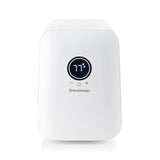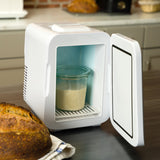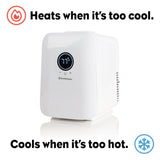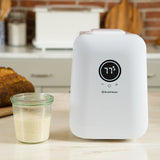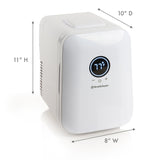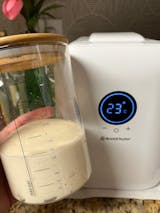
Key Benefits
- No need to feed–healthy starter without daily upkeep
- Reduce waste and save flour with fewer feedings
- Slow or speed up fermentation to fit your lifestyle
- Maintain a stable temperature for starter health & predictability
- A healthy bubbly starter = Better bread
Who Is It For?
- Weekend bakers who want to feed less frequently
- Daily bakers who want more reliable results
- Anyone dealing with seasonal temperature swings in their kitchen
- Bakers looking to reduce waste and simplify their sourdough routine

Sourdough, Simplified
Whether you're building a new starter or looking to simplify your routine, the Sourdough Home helps you create the right environment—no guesswork, no stress.

Slow down, Feed less
Speed up, Feed more
Cooler temperatures gently slow fermentation, giving you more flexibility in your schedule. Warmer settings encourage more activity, helping your starter rise quickly and stay bake-ready.
Cooler Settings
Perfect for:
- Weekend bakers who want to stretch time between feedings
- Reducing flour waste and discard
- Keeping your starter quietly thriving between baking sessions
Cooler temps gently slow fermentation, giving you more flexibility in your schedule.
Warmer Settings
Perfect for:
- Daily bakers looking for steady, predictable activity
- A fresh start with a new sourdough starter
- Warming up a sluggish starter after time off
Warmer settings encourage more activity, helping your starter rise quickly and stay bake-ready.
Sourdough, Simplified
Whether you're building a new starter or looking to simplify your routine, the Sourdough Home helps you create the right environment—no guesswork, no stress.
Temperature Settings

Cooler temperatures gently slow fermentation, giving you more flexibility in your schedule. Warmer settings encourage more activity, helping your starter rise quickly and stay bake-ready.
Need to build or revive your starter?
Warmth is essential for strong microbial growth. Set the Sourdough Home to a cozy temperature (around 76–78°F / 24–26°C) to help your culture become strong, active, and ready for baking.


Want to feed less often?
Dial down the temperature to slow fermentation and stretch the time between feedings to 2, 3, or even 5 days—without sacrificing a healthy, bubbly starter.
No matter the season—or your schedule—the Sourdough Home creates a stable environment that keeps your starter happy, consistent, and always ready when you are.
A Healthy Starter, Without the Hassle

A healthy, reliable starter starts with the right temperature. When conditions stay steady, your routine becomes easier—and your results more consistent.

Fewer feedings, less waste, and a starter that’s always ready. The Sourdough Home holds the perfect temperature to match your schedule.

Join the community of bakers who’ve simplified their sourdough routine with the Sourdough Home and made better bread in the process.
Sourdough Starter Maintenance
Heats when it's too cool.
Cools when it's too hot.
Low power usage
Sourdough starter is a living colony of yeast and good bacteria. Like any living thing it needs to eat - just flour and water. Feeding your starter the proper ingredients at the right time is the first step in creating great sourdough bread. Using the precise temperature control of the Sourdough Home, you can adjust starter feeding times to meet your schedule.
As starter ferments and grows, it creates CO2 bubbles that cause the mixture to rise in its container. The ideal time to feed starter is when the rise has peaked - all of its food has been consumed - and before it begins to fall again. By using a constant seed ratio (quantity of flour and water) and controlling the temperature, you can control the feeding schedule to hours, days or even a week. Use the guidelines below to get started.
| Temperature | Time to Feed | Seed Ratio |
|---|---|---|
| 7°C / 45°F | 5 Days / 120 Hours | 1:4:4 |
| 10°C / 50°F | 3 days / 72 hours | 1:4:4 |
| 12°C / 54°F | 2 days / 48 hours | 1:4:4 |
| 20°C / 68°F | 1 day / 24 hours | 1:4:4 |
Seed Ratio: This is the ratio of active culture to fresh flour and water. The more active culture used, the faster your starter will grow and peak. For daily maintenance a 1:4:4 ratio will keep your starter thriving without growing too fast.
Note: Your starter may vary slightly from these results depending on the flour used and the specifics of your culture.

















